IN THIS ISSUE
- Bird Island birds beat storm
- Searching for rare darters
- A trunk organizer for your 2 cents
- Sorting cottonmouth fact and myth
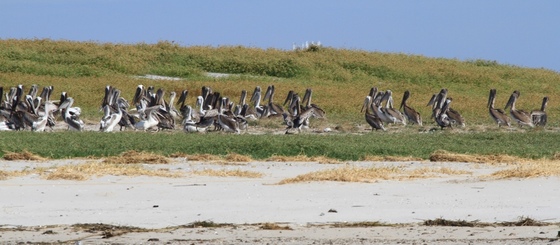 Post Irma, pelican chick survivors on dredge-spoil island (Tim Keyes/DNR)
As intended, the Brunswick dredge-spoil island has been a nesting hotspot for sea- and shorebirds since it was built in 2007. But the Spartan setting of sand, ground-hugging vegetation and rip-rap is no haven from hurricanes.
Which is why DNR wildlife biologist Tim Keyes was surprised when he checked the island just off Jekyll Island this week and saw that about 35 brown pelican chicks only about 8 weeks old had survived Irma.
“These guys would’ve just hunkered down” when the storm hit, Keyes said.
“I wasn’t expecting them to make it through.”
The pelican colony on what some call Bird Island had an estimated 82 nesting pairs at its peak this summer. The parents of the chicks that weathered Irma had nested later than normal, possibly re-nesting after high tides flooded their previous nest sites, said Keyes, who works with the agency's Nongame Conservation Section.
When Irma crossed into the state Sept. 11, it was veering west across central-southwest Georgia and had weakened to a tropical storm. But along the coast the storm still packed high winds – Jekyll recorded a gust of 77 mph, The Brunswick News reported – record storm surges and drenching rains.
Keyes said it helped that the pelican chicks were not on the island’s lowest shelf, though they were only about 6 feet above sea level on land that is only 14 feet at its tallest point. While the approximately 10-acre island suffered significant erosion along the north and eastern shores, the nesting habitat remains intact, he said.
Other seabird and shorebird nesting sites in Georgia didn’t fare as well. Keyes wrote in an email that Irma exacerbated the damage wrought by Hurricane Matthew last year: wiping out “what little was left” of Ogeechee Bar in the mouth of the Ogeechee River, erasing higher dune areas on Little Egg Island Bar in the Altamaha River and causing significant loss of dunes on the other islands he has checked so far.
As for the young pelicans on Bird Island, the adults are caring for them and they will fledge in two to four weeks, an Irma footnote to the resilience of wildlife.
For more on conserving shorebirds and seabirds in Georgia, check out Nongame Conservation Section’s annual report.
A BOON FOR BIRDERS
The storm blew many seabirds inland. Sightings of pelagic species at Georgia lakes included magnificent frigatebird, black-capped petrel, brown noddy, Cory’s and greater shearwater, Sabine’s gull, white-tailed tropicbird, bridled and sooty terns, and the state’s first inland record (on West Point) of an American oystercatcher.
Also see: “How do hurricanes affect birds?” at Audubon.org.
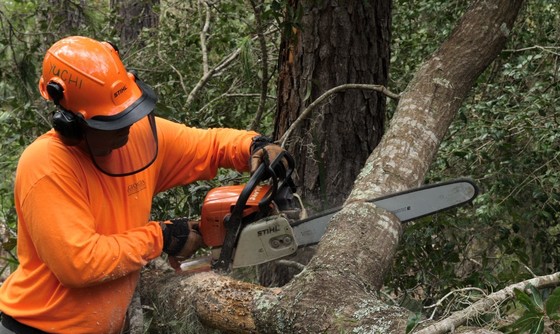 Clearing fallen trees (Heidi Ferguson/DNR)
STORM RESPONSE
Examples of DNR's statewide, multidivision response to Irma included:
- Clearing miles of roads, with Wildlife Resources Division debris removal teams and other staff logging more than 3,800 hours, or 475 man-days.
- Opening all state parks to shelter evacuees.
- Helping ensure the health, safety and welfare of communities, including providing security as evacuated areas were re-opened.
- Opening a call center for constituents regarding impacts to docks, marinas and other property in coastal waters, marshlands and along island beaches.
Back to top.
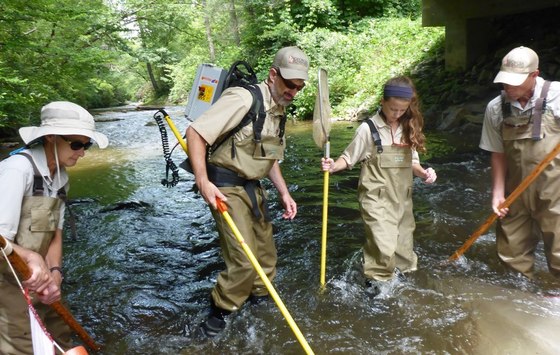 Electrofishing on the Etowah (Paula Marcinek/DNR)
By MELISSA KENEELY
As a seasonal field tech with DNR aquatic biologists, my work is seldom the same week to week. One week I might be in a creek in a south Georgia swamp, sifting sand through my fingers to find mussels. The next, I could be in a mountain stream in north Georgia, looking for endangered fish species.
Last month, it was the latter as we surveyed streams in the Etowah and Coosawattee River basins for holiday and bridled darters. Both species are state-listed as endangered and petitioned for listing under the Endangered Species Act.
Read more …
Melissa Keneely is a recent graduate of UGA’s Warnell School of Forestry and Natural Resources. Her previous post was “New job opens eyes to mussels.”
Explore images of our native fish species in the Fishes of Georgia Photo Gallery.
Back to top.
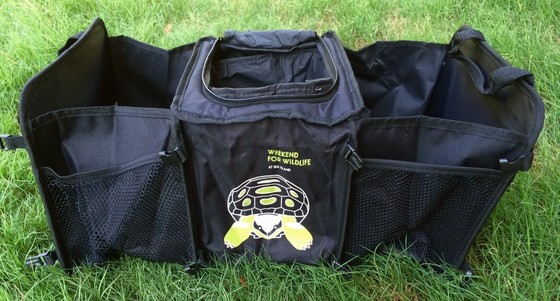 Weekend for Wildlife trunk organizer
What do you like or don’t like about Georgia Wild?
Tell us in the annual newsletter survey. Taking part can even simplify your life.
How so? Complete the survey, include your email – it’s one of the questions – and you will be entered in a drawing for a Weekend for Wildlife trunk organizer. Each organizer has a cooler in the middle and a cool gopher tortoise logo on the front.
Organize your car. Improve Georgia Wild, and thereby help conserve wildlife. It's a win-win-win.
Complete the survey before Oct. 1. We’ll let you know by Oct. 4 if you're one of the five winners. One entry per person, please. (DNR employees are not eligible to win.)
Take the survey.
Back to top.
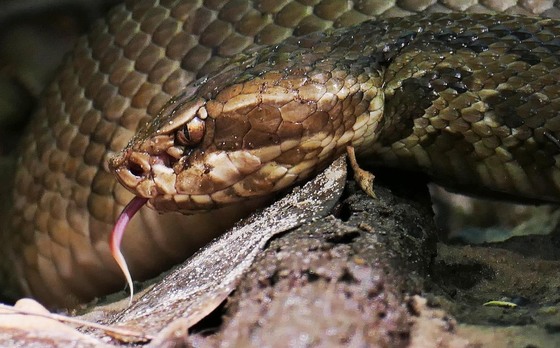 Cottonmouth up close (Matt Moore)
No other venomous snake native to Georgia can match cottonmouths when it comes to myth, mystique and downright confusion. The fallout varies from mistaken views on the species’ purported grumpiness to Georgia's five nonvenomous watersnake species all being called – and killed as – water moccassins.
To help sort fact from fiction, here’s an explanation of an on-the-water encounter videoed in Virginia, where a cottonmouth exhibits a common defensive behavior that is often wrongly perceived as aggression.
And in a recent Orianne Society article, Matt Moore discussed misconceptions about cottonmouths and misunderstanding spurred by the colloquial name “water moccasin.” (Readers may recall Moore's “Cottonmouth video undercuts myth” in the May 25 issue.)
Another helpful resource is DNR’s “Is it a water moccasin?” brochure.
Back to top.
The perilous plight of North Atlantic right whales – at least 14 of which have been found dead along the coast of Canada and the U.S. this summer – is explored in a Canadian Broadcasting Corp. series called “Deep Trouble.” Reports include this video and a story about a worker killed while trying to free a whale entangled in commercial fishing gear. (Also see: “Ruffian returns north,” an article and videos about the disentanglement of a right whale this year by DNR and partners.)
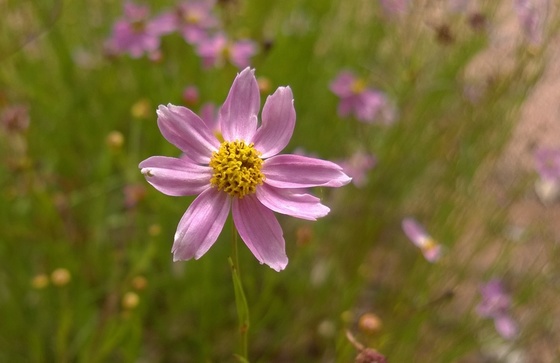 Pink tickseed at Tugaloo (Sabrina Sewell/DNR)
Newly hired as a rare plant survey and safeguarding technician, Nongame Conservation’s Sabrina Sewell discovered Georgia’s third known population of pink tickseed during a trip to Lake Hartwell. The globally vulnerable plant is more common along pond shores in the Northeast, and was likely distributed to Hartwell by waterfowl, DNR botanist Tom Patrick writes.
DNR is again offering a $1,000 grant to a third-, fourth- or fifth-grade public or private school teacher in Georgia who demonstrates exceptional energy and innovation in teaching life sciences. Oct. 16 is the deadline to apply for the Conservation Teacher of the Year grant funded by The Environmental Resources Network, or TERN, friends group of the Nongame Conservation Section.
More than 86 million Americans were involved in wildlife watching in 2016 and they spent an estimated $75.9 billion, according to preliminary findings in the latest U.S. Fish and Wildlife Service survey done every five years. Overall, the survey found that 40 percent of the U.S. population 16-and-older – 101.6 million people – fished, hunted or watched wildlife, ringing up $156.3 billion in expenditures, or $1 out of every $100 in goods and services produced in the nation. Compared to 2011, wildlife watching – people who had a special interest in wildlife around their home or a took trip primarily for wildlife watching – increased 20 percent in participation and 28 percent in expenditures. State-specific reports will be released later.
Ever heard a bat? Here’s a sample of bat calls recorded during North American Bat Monitoring sampling by DNR’s Emily Ferrall and Maggie Hunt at Cumberland Island National Seashore this summer. Bats echolocate at pitches humans cannot hear, but the Anabat device used here records the calls and lowers the frequency, providing call data scientists can use to identify species.
Back to top.
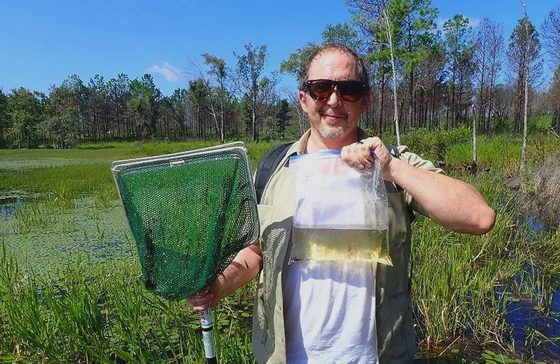 Amphibian Foundation Executive Director Mark Mandica with striped newt larva (Ryan Means)
Twenty-five striped newt larvae were collected at Sandhills Wildlife Management Area to boost captive collections where the imperiled species are being reared for reintroduction efforts, including in Apalachicola National Forest. Of the newts netted by Nongame Conservation senior wildlife biologist John Jensen and partners, 12 went to Amphibian Foundation and 13 to the Detroit Zoo.
DNR’s “Exploring Georgia’s wildlife” coloring book, a teaching aid for conservation that also explains the role wildlife license plates play, has been shared by the state Education Department with all third-grade teachers in Georgia. The book created by Nongame Conservation Environmental Outreach Coordinator Linda May and artist Ami Flowers Staples was funded TERN.
A partner-powered project to restore Raccoon Creek in Paulding County has been recognized as one of the Georgia Water Coalition’s Clean 13 for 2017. The organization's report highlights what it calls “extraordinary efforts” by individuals, businesses, nonprofits and governments that have led to cleaner water.
Names in the news: Following a promotion, DNR wildlife biologist Jason Wisniewski, longtime leader of mollusk conservation for the agency, will now also lead the Nongame Conservation Section’s aquatics team and projects. Botanist Dr. Mincy Moffett Jr. recently taught a botanical/ecological field seminar at Ohoopee Dunes Wildlife Management Area for a senior-level field biology class from Middle Georgia State University.
Back to top.
COMING UP
Sept. 23
– National Hunting and Fishing Day, including kids’ fishing events and a free fishing day statewide
– Monarchs across Georgia Pollinator Symposium, 9 a.m.-4 p.m., Monastery of the Holy Spirit, Conyers
-- Georgia Native Plant Society native plant sale, Stone Mountain Park, Stone Mountain
Sept. 27 – Annual fall meeting of Georgia Sea Turtle Cooperative members, 8:30 a.m.-noon, DNR Coastal Resources, Brunswick. Details.
Sept. 28 – Georgia Prescribed Fire Council annual meeting, UGA Tifton Campus Conference Center, Tifton
Sept. 30 -- Your State Parks Day, sponsored by Friends of Georgia State Parks & Historic Sites. Features volunteer events benefiting parks, including storm clean-up and removing invasive plants.
Oct. 7 – CoastFest 2017, DNR Coastal Regional Headquarters, Brunswick
Oct. 13-15 -- Gopher Tortoise Council annual meeting, National Wild Turkey Federation, Edgefield, S.C.
Oct. 14 -- Rivers Alive event removing Chinese privet at Mill Creek Nature Center, 9 a.m. Includes wildlife presentation by DNR's Linda May. Details.
Oct. 19-20 – Georgia Plant Conservation Alliance sixth annual symposium, Chattahoochee River National Recreation Area, Sandy Springs
Oct. 20 – Outdoor Learning Symposium, Environmental Education Alliance of Georgia, Southwest Atlanta Christian Academy, Atlanta
Oct. 21 -- Reptiles Alive! 2017, Westin Savannah Harbor Golf Resort and Spa. Sponsored by resort and Friends of the Savannah Coastal Wildlife Refuges.
Nov. 3-5 – Becoming an Outdoors-Woman workshop, Charlie Elliott Wildlife Center, Mansfield. Scholarships are available (apply by Oct. 16).
WHAT YOU MISSED ...
in the last Georgia Wild.
- Why caterpillars are key
- Partnership powers mussel work
- Team Tortoise bodes well for gophers
Back to top.
"Saving Georgia’s state reptile," Saporta Report. Also: Georgia Trend.
"Beavers in Buckhead?" including interview with DNR's Linda May, WABE-FM (90.1, Atlanta)
(+video) "Aiken, S.C., family finds snake in toilet," WRDW-TV (Ch. 12, Augusta)
"Even sea turtles' taste buds change with age," bioGraphic
"Georgia Power, U.S. Fish and Wildlife, DNR partner to protect mollusks," Metro Atlanta CEO
"At least 14,003 plant species in Amazon rain forest," Atlas Obscura, citing study in Proceedings of the National Academy of Sciences
"Savannah’s orbweaver spiders eat bad insects in garden," Savannah Morning News
(+video) "Manatees rescued from pond after being trapped by Irma," USA Today
"Whale’s baleen bristles reveal story of its life," Smithsonian.com
VIDEO AND AUDIO
"Snot otters get a second chance in Ohio," National Public Radio
(audio) "Nighttime flights of songbirds," BirdNote
New video of wild jaguar in Arizona, Center for Biological Diversity
"Endangered grebe's mesmerising display filmed for first time," BirdLife
Back to top.
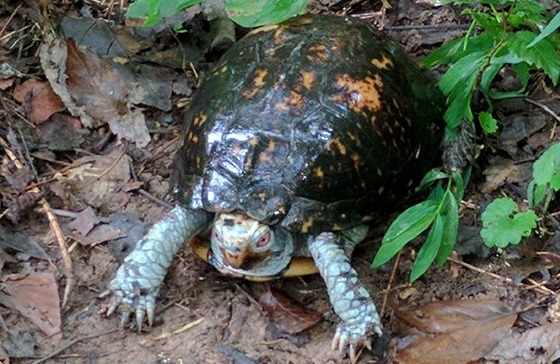 Box turtle in Georgia with pigment anomaly (Jim Allen)
Why is this eastern box turtle blue? The turtle, seen in Cherokee County, is not painted – which would be illegal – or infected. Instead, the blue tint is a genetic pigment anomaly, writes Dr. Jessica McGuire, manager of the DNR Wildlife Resources Division’s Private Lands Program. Because of the unique look, box turtles with this condition are highly prized in the pet trade, McGuire said. Possessing or selling a box turtle is illegal in Georgia.
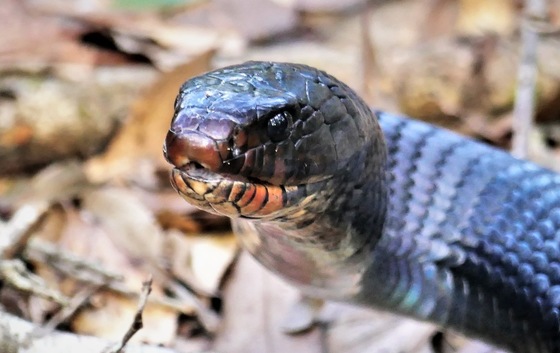 Eastern indigo (Matt Moore)
This eastern indigo snake was spotted recently in a dry, south Georgia swamp floodplain.
Already rare, indigos are scarcely seen in spring through early fall as they range
far from winter retreats in upland sandhill habitats. The species is
non-venomous, federally protected as threatened and can grow longer than
8 feet. The male shown here, reported by Matt Moore and Dirk J.
Stevenson, was about 6.5 feet. Indigos are highly resistant to the venom
of pit vipers, including rattlesnakes, copperheads and cottonmouths,
and will eat venomous and non-venomous snakes.
Masthead image: breeding male holiday darter (Brett Albanese/DNR)
Back to top.
|